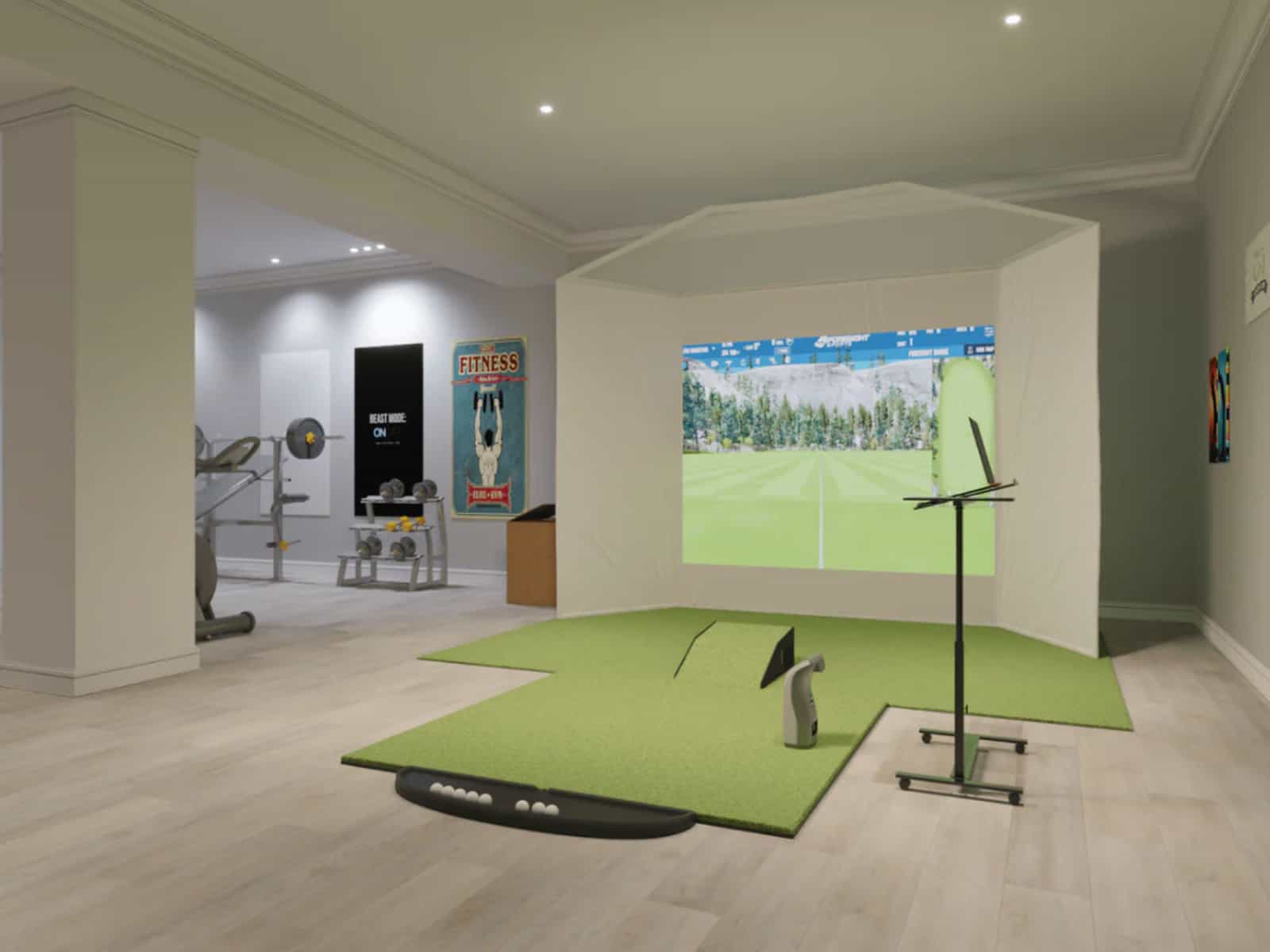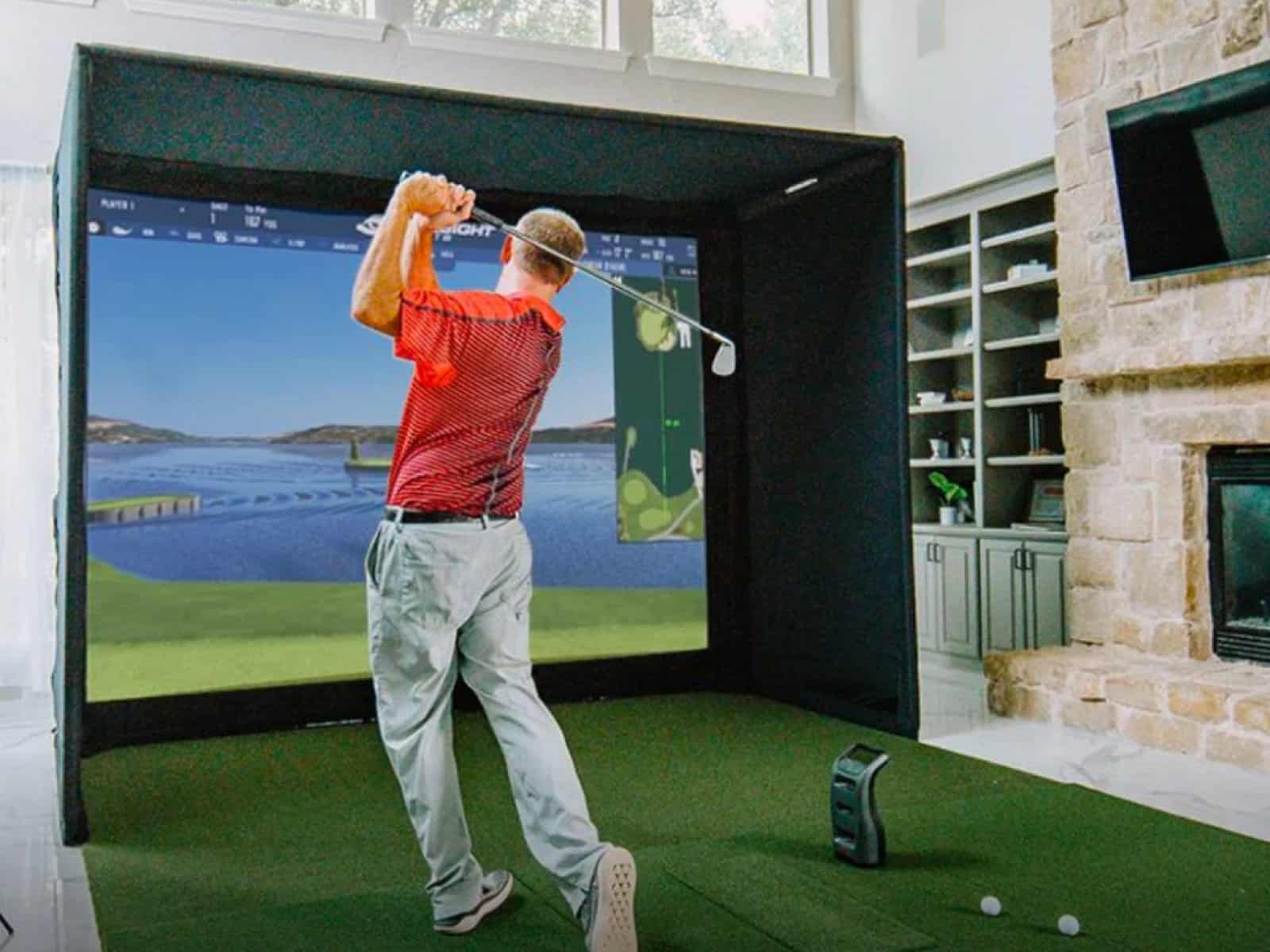Over the past decade, golf simulators have risen greatly in popularity and accessibility. What was once mostly found only at professional fitting studios and elite training centers is now available for home and commercial entertainment use. Major technological advances have enabled very realistic golf simulator experiences that can replicate actual ball flights and course play.
But an important question for golfers considering using a simulator is – just how accurate are they? Can you trust the swing data and shot outcomes from a simulator to improve your real on-course game?
This article will explore in detail the key accuracy considerations for modern golf simulators. It covers how accuracy is actually measured, the various factors that influence it both positively and negatively, and the current state of precision across different golf metrics like ball speed, launch angles, carry distance calculations, etc.
If you’re curious about which simulators are trusted by the world’s greatest pro golfers, check out our article on what golf simulator pros use.
Golf Simulator Technology
Modern golf simulators rely on advanced technology to recreate the golf experience indoors. Most systems use a combination of cameras, radar, sensors, and infrared light to precisely track both the clubhead and the ball during the swing and after impact.
Photometric Technology
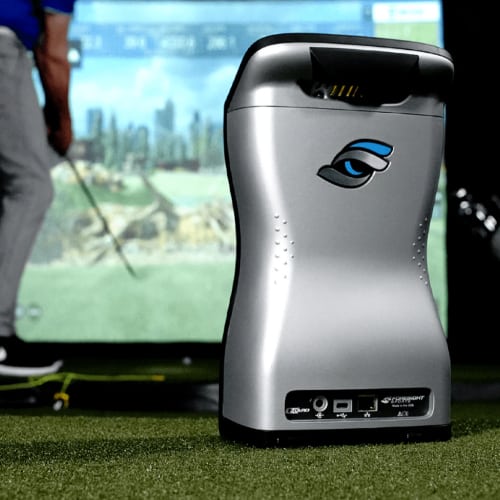
High-speed cameras capture images of the ball and provide detailed data on parameters like shot shape, distance, launch angle, backspin rate, and side spin. These don’t require a lot of indoor space to function properly, which makes them the best technology to use for indoor simulation. High-end models like the FS GCQuad are very accurate even outdoors, but they are unbeatable in an indoor setting.
Infrared Technology
Infrared simulators take a simpler approach by emitting light signals to monitor the clubhead’s position throughout the swing, although these tend to be less accurate compared to camera and radar-based systems. One of the most affordable and popular Infrared-only simulators is the Optishot 2, which uses rows of infrared sensors to track the club and provide club data only.
Doppler Radar Technology
The most accurate simulators available today utilize Doppler radar, the same technology found in weather tracking. The radar continuously monitors the ball in flight to give unparalleled precision on all shot metrics, making these simulators ideally suited for both indoor and outdoor use (but better outdoors, since they require a longer ball flight distance to provide optimal accuracy.
However, for golfers on a tighter budget, launch monitors can provide valuable data without the need for a full simulator setup. For a deeper dive into the distinctions between launch monitors and golf simulators, check out our article on the difference between a launch monitor and golf simulator.
Hybrid Tracking Systems
While infrared alone provides very limited information, the combination of cameras and radar offers the best of both worlds in monitoring the club and ball. This technology combination is what allows modern simulators to realistically simulate famous courses and provide golfers with valuable feedback to improve their games. This hybrid tracking technology can be found in Trackman 4, Flightscope’s X3, Skytrak Plus and Full Swing’s Kit launch monitors, among others.

Advanced photometric systems also combine technologies and use cameras and infrared sensors to maximize accuracy; this combination is found in Foresight’s GC3, GCQuad and GCHawk, Uneekor’s EYE XO, EYE Mini, QED, and EYE XO2, etc.
How Accuracy is Measured
To understand the accuracy of golf simulators, it’s important to first look at how they actually quantify and measure the various swing and ball flight parameters. Sophisticated photometric technology and radar systems track both the golfer’s swing path and the ball’s launch and flight after impact.
Key metrics that are monitored by simulators include:
- Club speed
- Club face angle
- Angle of attack
- Swing path
- Ball speed
- Launch angle
- Spin rate
- Carry distance
- Dispersion and curvature
For indoor simulators, high-speed cameras or Doppler radar systems are used to track the club and ball after impact. The data is analyzed by software to produce the key swing and shot measurements.
The overall accuracy is determined by how closely the simulator measurements match up with real-world conditions when that same golfer hits shots on an actual course. The best and most useful simulators aim for a high correlation between the simulator ball flight numbers and on-course performance.
Of course, no simulator will be able to reproduce exact on-course results every time perfectly. However, the highest quality systems seek to minimize variability and have swing data and shot outcomes that align as closely as possible to real shots. This builds confidence that the simulator is providing reliable information to help improve your game.
Factors That Impact Golf Simulator Accuracy
While golf simulator technology has improved dramatically, there are several factors that still impact the accuracy and realism of simulators today. The key components that determine how precisely a golf simulator can track shots and replicate the true golfing experience include:
Club Tracking and Sensors
The club tracking sensors are critical for capturing swing data. Systems use optical, radar, or camera-based sensors to follow the club path, face angle, and speed. More sensors generally improve tracking accuracy, and high-end simulators have sensors that capture data at thousands of reference points during the swing.
The placement of the sensors also affects accuracy, as multiple distributed sensors capture more swing data than a single clubface sensor.
Simulator Software and Analytics
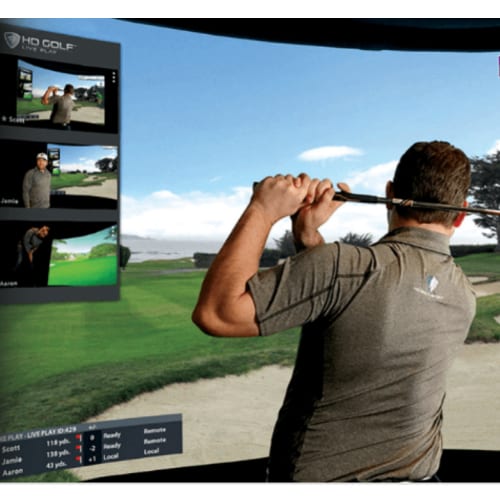
The software needs to accurately model ball flight physics and factors like spin, launch angle, and environmental conditions. Sophisticated software considers golfer swing mechanics and equipment. But even high-end software has limitations in modeling every nuance of real golf shots.
The more data points the sensors capture, the more data the software has for analysis, which helps with accuracy.
Environmental Controls
Simulators use environmental controls to mimic factors like wind, elevation changes, temperature, and humidity. The more advanced the environmental modeling, the more realistic the shot outcomes. Still, budget simulators may lack the necessary environmental controls.
Make sure you optimize the environmental settings, including temperature, humidity and elevation to make the virtual setting as close to the real playing conditions on the course as possible. This will ensure that the numbers you get indoors and on the course are as close as possible.
Calibration and Customization
Each golfer’s swing produces unique ball flight patterns, so custom calibration is key for accuracy. Optimal simulator setup requires precisely dialing in factors specific to your swing profile and equipment. You need to define which club you’re using for each shot to help the sim algorithms produce more accurate data and simulation.
Also, calibrating the sensors of your simulator (the launch monitor, to be more precise) is crucial if you want your virtual experience to be as accurate as possible. Every manufacturer provides guides on how to calibrate their units, so make sure you follow them.
Enclosure and Screen
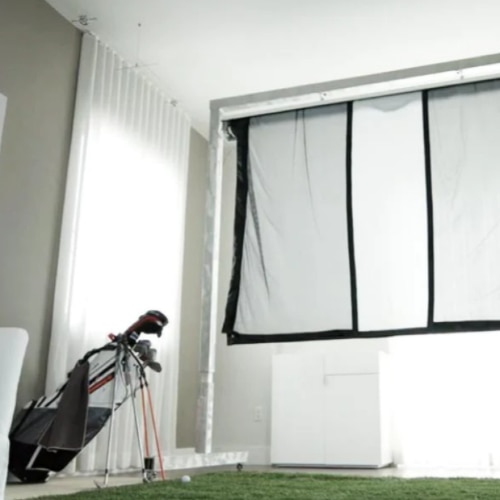
The screen materials affect how realistic shots look and feel. High-end enclosures use specialized impact screens and materials to emulate grass interaction. The display size, resolution, and distance to the golfer also influence perceived accuracy.
Thoughtful enclosure engineering is also needed to allow space for realistic ball flight and club movement. Cheaper enclosures can limit swing motion and ball-shot shaping.
Golf simulator accuracy depends on advanced sensor technology, sophisticated software, environmental controls, custom calibration, and high-quality enclosure engineering. Continued innovation in these areas will further enhance simulator realism and accuracy.
Accuracy for Key Golf Metrics
While many factors influence the overall accuracy of golf simulators, examining the precision for specific swing and shot metrics provides deeper insight. Certain parameters are measured very accurately, while others have more discrepancy compared to real-world conditions.
Swing Analysis
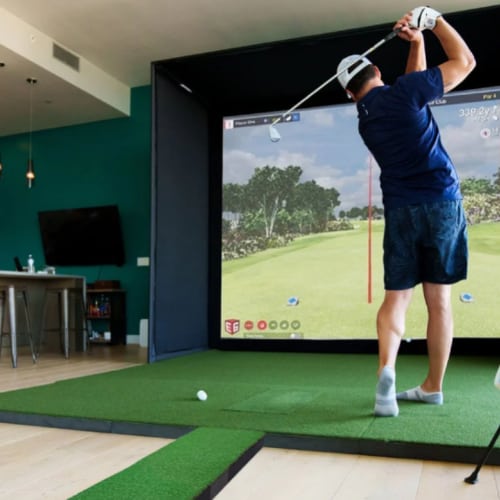
For swing analysis, today’s top simulator systems are highly accurate for club measurements like clubhead speed, angle of attack, swing path, and face angles across the entire swing arc. This allows for a very meaningful analysis of swing mechanics and adjustments to improve technique.
Ball Speed and Launch
The direct ball speed coming off the clubface is also measured very precisely by both photometric and radar systems. This builds confidence in the ball flight predictions. Launch angle and spin rates are quite accurate, especially when conditions are well controlled.
Carry Distance
Carry distance or total yardages of shots do tend to be overestimated compared to actual on-course performance, sometimes significantly so. Advanced simulators are improving their algorithms to better match expected carry distances across clubs and shots.
Curvature and Dispersion
Simulators can match the curvature of straight shots and fades/draws quite well when impacts are near the center of the face. However, truly modeling dispersion, shot shape and accuracy across the clubface is a complex and ongoing challenge.
In summary, simulators are excellent for analyzing swing metrics and ball speeds. However, certain ball flight outcomes still have limitations in accuracy compared to real on-course performance. Understanding these distinctions allows golfers to focus practice on the most reliable data.
Accuracy of Leading Golf Simulator Brands
The major golf simulator brands on the market today include some key differences when it comes to accuracy capabilities. Evaluating the technology and user reviews of top brands can help identify which solution may best fit your needs and budget.
Overview of Top Brands
Some of the leading most accurate golf simulator manufacturers are:
- HD Golf – A leading Canadian brand that produces some of the most realistic and expensive systems.
- Foresight Sports GCQuad & GCHawk – High-end accuracy with quadrascopic photometric tracking and premium enclosure, usually used by pros.
- TrackMan – Powerful dual radar sensors for precision swing analysis; today, Trackman has become the benchmark of accuracy in the virtual golf world.
- Full Swing – Sophisticated dual tracking sensors and simulator software; the brand favored and endorsed by non other than Tiger Woods.
- FlightScope X3 – Radar-based simulators focused on highly detailed swing metrics (over 50); this system is more suitable for pros or advanced players.
- SkyTrak – Affordable launch monitors packed with shot analytics. Their latest Skytrak Plus combines camera tracking with Doppler radar to enhance the accuracy of the original unit.
- AboutGolf – Realistic simulators using advanced 3D motion sensors and extremely realistic enclosures and graphics. These are some of the most advanced systems available today.
Check Also: The Most Accurate Golf Simulators In The Market – Reviews & Buying Guide
Technical Comparison of Accuracy Features
In terms of technical accuracy capabilities, HD Golf, Foresight Sports, Trackman, and Full Swing generally lead with the most advanced club and ball tracking utilizing multiple high-speed cameras or radar. FlightScope also offers impressive radar accuracy for swing analysis. SkyTrak provides excellent value for the price with very good accuracy. Lower-cost options like Optishot use fewer sensors but can still provide good club feedback.
Accuracy vs. Cost Considerations

In general, the more expensive golf simulator systems like a professional HD Golf or Trackman setup provide the highest levels of true shot replication. Mid-range options offer outstanding swing analysis and solid overall accuracy for the price. Budget golf simulators are fantastic for entertainment and basic skills practice, but lack the precision of top-tier solutions.
Optimizing Simulator Accuracy
While there are certain inherent limitations with current golf simulator technology, there are several ways to optimize their accuracy and get the most precise measurements from your simulator practice and training:
- Perform regular sensor calibration and maintenance to ensure optimal tracking. Most manufacturers provide calibration procedures. Plan regular checkups and recalibration, and make sure you stay up-to-date with simulator software updates. These often include improvements that enhance accuracy.
- Control the indoor environment as much as possible by regulating temperature, humidity and elevation in your simulator software, and try to match them to the actual playing conditions. This will unify the variables across real and virtual golf to allow you to assess the accuracy of the virtual system.
- Use the exact same clubs and golf balls that you play with on the course to improve correlation.
- Focus most on highly accurate metrics like clubhead speed, swing path, ball speed, etc. Take carry distances and dispersion with a grain of salt, especially if you’re using a low or mid-range system (as premium models tend to do better).
- Treat simulator distances and shot outcomes as relative rather than absolute figures compared to the real world. Look for consistency. The data doesn’t have to be an exact match, but just close and consistent enough to help you practice and improve your game consistently.
- Work with the manufacturer or installer to optimize camera positions, lighting, impact screens, and other things that maximize accuracy. Proper setup of all the components greatly improves accuracy.
- Pay special attention to your launch monitor placement, as it can make your game or break it. Radar systems are usually positioned behind the tee point, while portable photometric units are placed in front of the player, perpendicular to the target line. Overhead launch monitors like Uneekor’s EYE XO2 or Foresight Sports GCHawk are installed on the ceiling, a few feet in front of the hitting area.
Golf simulator technology continues to rapidly improve, and understanding the current factors impacting accuracy and taking steps to optimize your simulator setup will ensure you get the most out of your practice. When used properly, golf simulators can be extremely effective tools for improving your game.
So, How Accurate AreGolf Simulators?

Golf simulators can be quite accurate in measuring and analyzing various aspects of a golfer’s swing and shot performance, but their level of accuracy depends on several factors, including technology, quality, setup, environment, maintenance, swing profile, etc.
High-end golf simulators under controlled conditions and optimized for an individual’s swing can indeed achieve upwards of 95% accuracy in analyzing most shot metrics, providing very realistic and useful data. However, more affordable simulators may be limited to around 90% accuracy or less. Regular calibration and comparing to real-world golf shots help maximize accuracy.
Final Thoughts
Today’s advanced golf simulators can be excellent practice and training tools when their accuracy factors are well understood.
Optimizing accuracy requires paying close attention to sensor calibration, environmental control, and proper equipment placement. With realistic expectations and maximizing accuracy where possible, golf simulators provide an invaluable ability to practice and analyze your golf game indoors.
While there is still room for improvement as the technology evolves, today’s leading golf simulator systems deliver on their promise to enhance skills, provide meaningful data, and lower scores on the course. Their accuracy continues to reach impressive levels across many golf metrics when properly implemented.

